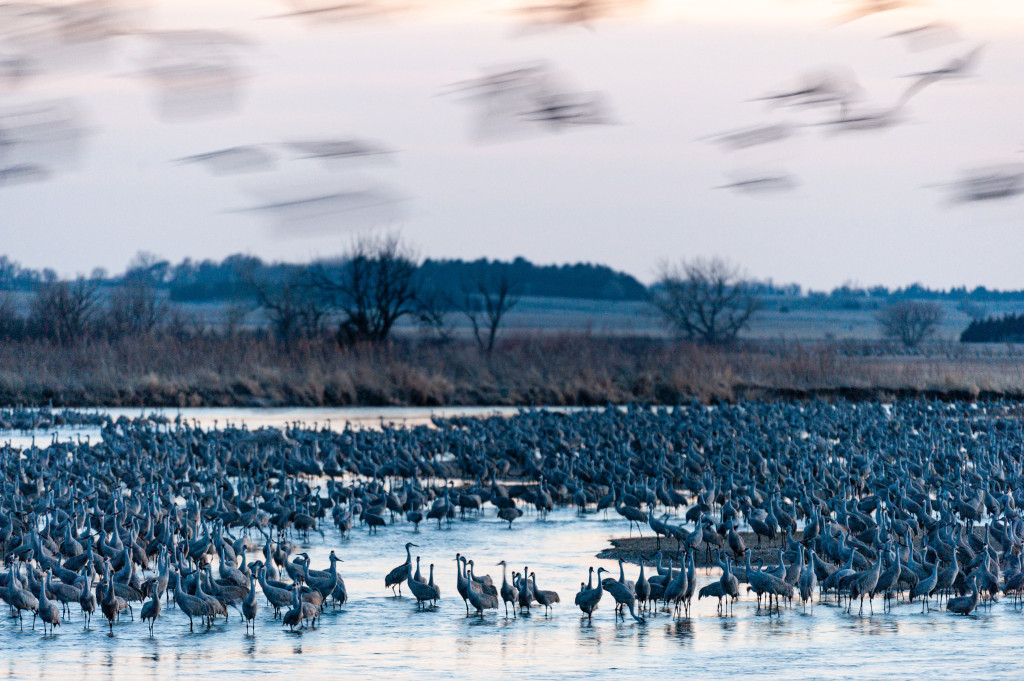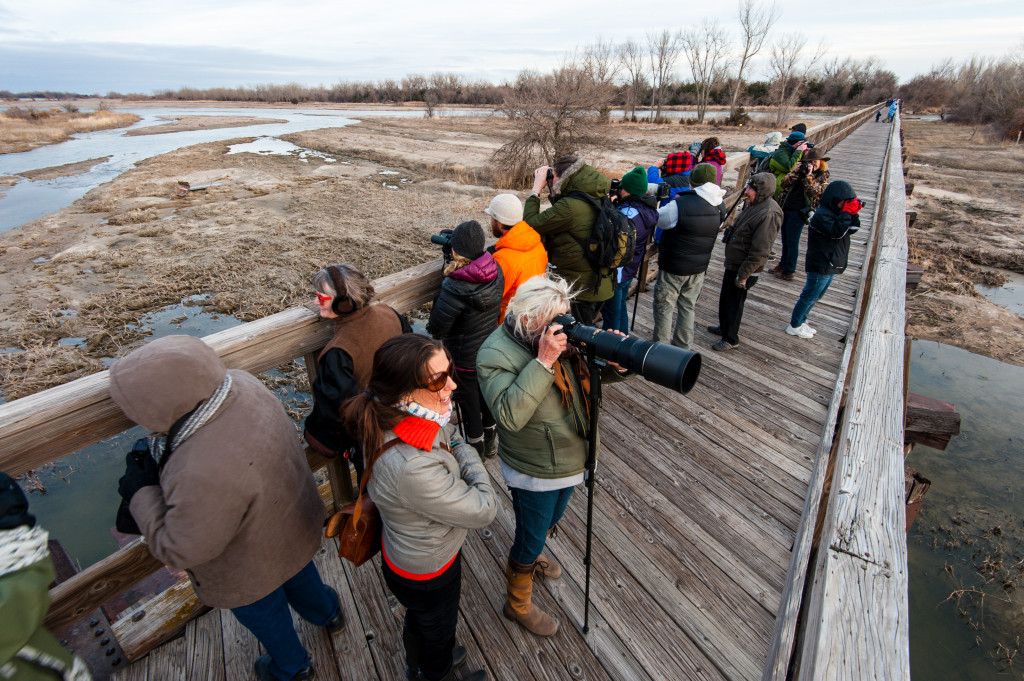
By Olivia DaRugna, Watchable Wildlife Biologist
Observing the convergence of over a million sandhill cranes along the Central Platte River is like immersing yourself in a nature documentary. The sandhill crane migration is truly one of the world’s greatest wildlife spectacles, on par with the awe-inspiring caribou migrations across northern Alaska and Canada or the mass movement of wildebeest herds across the Serengeti in Tanzania. The best part about the sandhill crane migration is that Nebraska residents don’t have to travel far to experience it.
Did you know sandhill cranes have been around nearly 2.5 million years? They are one of the oldest species of birds; a fossil found in northeastern Nebraska of a close relative to the modern sandhill crane dates back even further to 10 million years old. So, when you’re in the presence of this magnificent animal, you are seeing them as they were millions of years ago. The longevity of cranes has inspired people throughout history, as seen in cultures all over the world through stories, art and festivals.
In Nebraska, sandhill cranes are celebrated. Beginning mid-February to mid-April, thousands of sandhill cranes gather, with peak numbers seen between early March and early April. Nebraska’s Central Platte River and the surrounding fields and prairies provide rest stops along the birds’ migration north. They fatten up on waste grain in the cornfields and rest at night in the shallow river, where they are more protected from predators, such as coyotes. Their stay in Nebraska provides crane enthusiasts a feast for the senses.
Everyone describes the cacophony of sandhill crane a little differently, ranging from rattles, to trumpets, to croaks and a variety of other sounds. These calls are a product of the birds’ uniquely long and looped trachea, which also amplifies the sounds they make for about a mile.
As Paul Johnsgard has said, “Of all avian sounds, few have the power to catch the human imagination and thrill the senses as much as does the bugling of a flock of distant cranes.”
This is a wildlife experience like no other, so mark a couple days off in your calendars to see this incredible phenomenon. Visit a viewing blind or crane viewing platform in the early morning or evening as the birds congregate together in the river for the best chances of hearing this crane concert. The following are a few tips to view cranes.

Guided Tours
Guided tours range widely in pricing, location and viewing opportunities. They offer up-close viewing of sandhill cranes, plus beautiful sunrises and sunsets. Reservations are usually available starting in early January, and many will sell out, so book early. Visit https://nebraskaflyway.com/crane-viewing/ for options.
Self-guided Tour
If guided tours are not your style or reservations are sold out, don’t fret. There are many places to explore on your own to see cranes throughout the day.
To view cranes gracefully flying into their roost sites in the evening or taking off in the early morning, visit sites like the Plautz Crane Viewing Platform south of Gibbon, the Alda Crane Viewing Bridge south of the Crane Trust or the Fort Kearny hike-bike trail where the bridge crosses the Platte River.
There is also a free crane-viewing blind at North River Wildlife Management Area; this blind is first-come, first-served and requires about a 0.5-mile hike to get to it.
Driving Tour
During the day, the cranes forage in adjacent fields. For the best viewing options, use the Nebraska Flyway crane-viewing map to find multiple roadside viewing sites. From these designated areas, watch the large-bodied birds as they walk on their stilt-like legs through the corn stubble, using their long necks and bills to pick at grains, snails and other small invertebrates.
Also, visit Mormon Island and Windmill state recreation areas for more viewing opportunities.
To learn more about sandhill cranes, stop by one of the many visitor centers including the Crane Trust, Audubon’s Rowe Sanctuary and Fort Kearney State Historical Site. For more information about viewing sandhill cranes and links to live crane-viewing cameras, visit the Nebraska Birding Guide website.
Be a Good Observer
No matter how or where you decided to view sandhill cranes, make sure you come prepared. Wear plenty of warm layers, including hats and gloves. Binoculars and a viewing scope are helpful if you have access to them. Don’t forget a camera, but make sure to turn off the flash so you don’t scare the cranes.
- While driving along roads looking for cranes, use designated pull-offs for safety.
- Sandhill cranes are skittish, so use your car as a viewing blind.
- Stay quiet and still while viewing the birds.
- Do not approach the cranes.
- Respect property boundaries, as most of the land around the Platte River Valley is private.
Whooping cranes will occasionally show up in a flock of sandhill cranes. They stand out with their bright white plumage and slightly larger size. If you see one, please report your sighting here.
